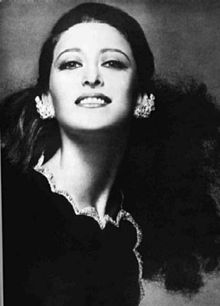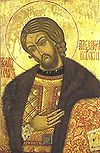- Maya Plisetskaya
-
Maya Plisetskaya 
Promotional photo of Plisetskaya used by the Bolshoi Ballet.Born November 20, 1925 (age 86)
Moscow, Soviet UnionOccupation ballerina Maya Mikhailovna Plisetskaya (Russian: Майя Михайловна Плисецкая, scientific transliteration: Majja Michajlovna Pliseckaja), born November 20, 1925 is a Russian ballet dancer, frequently cited as one of the greatest ballerinas of the 20th century. Maya danced during the Soviet era at the same time as the great Galina Ulanova, and took over from her as principal of the Bolshoi in 1960. Maya Plisetskaya is a naturalized Spanish and Lithuanian citizen.
Contents
Early life
Maya Plisetskaya was born in Moscow into a prominent Jewish family.[1] She went to school in Spitsbergen, where her father worked as an engineer and mine director.
In 1938, her father, Michael Plisetski was executed during the Stalinist purges, possibly because he had hired a friend who had been a secretary to Leon Trotsky. Her mother Rachel Messerer-Plisetskaya (aka Ra Messerer), a silent-film actress, was arrested and sent to a labor camp (Gulag) in Kazakhstan,[2] together with Maya's seven-month old baby brother.[3] Thereupon Maya was adopted by her maternal aunt, the ballerina Sulamith Messerer, until her mother was released in 1941.[4]
Maya studied under the great ballerina of imperial school, Elizaveta Gerdt. She first performed at the Bolshoi Theatre when she had just turned 11 years of age. In 1943, she graduated from the choreographic school and joined the Bolshoi Ballet,[4] where she would perform until 1990.Career
Plisetskaya with her husband, Rodion Shchedrin, in 2009
 Plisetskaya receives a governmental award from President of Russia Vladimir Putin on 20 November 2003.
Plisetskaya receives a governmental award from President of Russia Vladimir Putin on 20 November 2003.
From the beginning, Maya was a different kind of ballerina. She spent very short time in the corps de ballet after graduation and was quickly named a soloist. Her bright red hair and striking looks made her a glamorous figure on and off the stage. Her long arms had a fluidity that to this day remains unmatched; her interpretation of The Dying Swan, a short showcase piece made famous by Anna Pavlova, became Maya's calling card. Maya was known for the height of her jumps, her extremely flexible back, the technical strength of her dancing, and her charisma.
Despite her acclaim, Maya was not treated well by the Bolshoi management. She was Jewish[1] in an anti-Semitic climate, her family had been purged during the Stalinist era and her personality was defiant, so she was not allowed to tour outside the country for six years after joining the Bolshoi.[2] It wasn't until 1959 that Nikita Khrushchev permitted her to travel abroad,[5] and Plisetskaya could tour internationally. Her ability changed the world of ballet, setting a higher standard for ballerinas both in terms of technical brilliance and dramatic presence.
Maya's most acclaimed roles included Odette-Odile in Swan Lake (1947) and Aurora in Sleeping Beauty (1961). In 1958, she was honoured with the title of the People's Artist of the USSR and married the young composer Rodion Shchedrin, in whose subsequent fame she shared.
After Galina Ulanova left the stage in 1960, Maya Plisetskaya was proclaimed the prima ballerina assoluta of the Bolshoi Theatre. In the Soviet screen version of Anna Karenina, she played Princess Tverskaya. In 1971, her husband the composer Rodion Shchedrin wrote a ballet on the same subject, where she would play the leading role. Anna Karenina was also her first attempt at choreography.[6] Other choreographers who created ballets for her include Yury Grigorovich, Roland Petit, Alberto Alonso, and Maurice Béjart with "Isadora".
In the 1980s, Plisetskaya and Shchedrin spent much time abroad, where she worked as the artistic director of the Rome Opera Ballet in 1984–5, then the Spanish National Ballet of Madrid from 1987–9. At the age of 65, she finally retired from the Bolshoi as a soloist. On her 70th birthday, she debuted in Béjart's piece choreographed for her and entitled "Ave Maya". Since 1994, she has been presiding over the annual international ballet competitions called Maya. In 1996 she was named President of the Imperial Russian Ballet.[7]
She was forced to be member of the Anti-Zionist Committee of the Soviet Public by being threatened with having her passport revoked.[citation needed] When she traveled abroad in the 1960s, the Soviet secret police requested that she encourage the interest of Robert Kennedy, which she declined.[2]
On her 80th birthday, the Financial Times summed up current opinion about Maya in the following words: "She was, and still is, a star, ballet's monstre sacre, the final statement about theatrical glamour, a flaring, flaming beacon in a world of dimly twinkling talents, a beauty in the world of prettiness."[8] The following year, Emperor Akihito presented to her the Praemium Imperiale, informally considered a Nobel Prize for Art.
Later in life while touring in the United States she joined the fight for women's rights.
Awards and honors
Maya Plisetskaya has been honored on numerous occasions for her skills:[7]
- First prize, Budapest International Competition, 1949.
- People's Artist of the RSFSR, 1951.
- People's Artist of the USSR, 1959.
- Anna Pavlova Prize, 1962.
- Lenin Prize, 1964.
- Hero of Socialist Labour, 1985.
- Chevalier de la Légion d'honneur, 1986.
- Triumph Prize, 2000.
- Praemium Imperiale (in Hornor of Prince Takamatsu, Japan), 2006.
References
- ^ a b Miller, Jack (1984). Jews in Soviet Culture. Transaction Publishers. ISBN 0878554955.
- ^ a b c Eaton, Katherine Bliss (2004). Daily Life in the Soviet Union. Greenwood Publishing Group. ISBN 0313316287.
- ^ They were sent to ALZHIR camp, a Russian acronym for the Akmolinskii Camp for Wives of Traitors of the Motherland, "enemies of the people" [1] near Akmolinsk
- ^ a b Plisetskaya, Maya (2001). I, Maya Plisetskaya. Yale University Press. ISBN 0300088574.
- ^ Taubman, William; Khrushchev, Sergeĭ; Gleason, Abbott; Gehrenbeck, David; Kane, Eileen; Bashenko, Alla (2000). Nikita Khrushchev. Yale University Press. ISBN 0300076355.
- ^ Tolstoy, Leo (2003). Anna Karenina. Mandelker, Amy; Garnett, Constance. Spark Educational Publishing. ISBN 1593080271.
- ^ a b Sleeman, Elizabeth (2001). The International Who's Who of Women (3rd edition ed.). Routledge. ISBN 1857431227.
- ^ Crisp, Clement (2005-11-18). "Mayan goddess". Financial Times. http://www.ft.com/cms/s/0/34f00066-566f-11da-b98c-00000e25118c.html?nclick_check=1. Retrieved 2008-06-25.
External links
People from Russia Leaders and religious - Pre-1168
- 1168–1917
- 1922–1991
- 1991–present
- RSFSR leaders
- General secretaries
- Soviet premiers (1st deputies)
- Soviet heads of state (and their spouses)
- Prime ministers (1st deputies)
- Foreign ministers
- Prosecutors general
- Metropolitans and patriarchs
- Saints

Military and explorers - Field marshals
- Soviet marshals
- Admirals
- Aviators
- Cosmonauts
Scientists and inventors - Aerospace engineers
- Astronomers and astrophysicists
- Biologists
- Chemists
- Earth scientists
- Electrical engineers
- IT developers
- Linguists and philologists
- Mathematicians
- Naval engineers
- Physicians and psychologists
- Physicists
- Weaponry makers
Artists and writers Sportspeople - Chess players
Categories:- Prima ballerina assolutas
- Russian ballet dancers
- Spanish ballet dancers
- People's Artists of the USSR
- Lenin Prize winners
- Spanish Jews
- Russian Jews
- Spanish people of Russian descent
- 1925 births
- Living people
- Order of Merit for the Fatherland recipients
Wikimedia Foundation. 2010.



